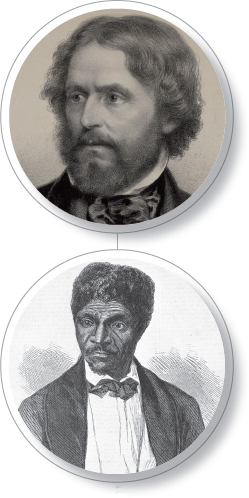Exploring American Histories: Printed Page 361
Exploring American Histories, Value Edition: Printed Page 298
American Histories: John C. Frémont and Dred Scott
AMERICAN HISTORIES

John C. Frémont, a noted explorer and military leader and the first presidential nominee of the Republican Party, rose from humble beginnings. He was the illegitimate child of Anne Beverley Whiting Pryor of Savannah, Georgia, who abandoned her wealthy husband and ran off with a French immigrant, Jean Charles Fremon. As a young man, John changed his last name to Frémont, either reclaiming the original spelling or seeking to create a more aristocratic one. He attended the College of Charleston, where he excelled at mathematics, but was eventually expelled for neglecting his studies. Frémont was hired to teach aboard a navy ship in 1833 through the help of an influential South Carolina politician. He then obtained a surveying position to map new railroad lines and Cherokee lands in Georgia and was finally appointed a second lieutenant in the Corps of Topographical Engineers.
In 1840 Lieutenant Frémont traveled to Washington, D.C., to assist in publishing maps and reports from an expedition along the upper Mississippi River. The following year, the twenty-eight-year-old explorer eloped with Jessie Benton, the seventeen-year-old daughter of Missouri senator Thomas Hart Benton. Despite the scandal, Senator Benton supported his son-in-law’s selection for a federally funded expedition to the West. In 1842 Frémont and his guide, Kit Carson, led twenty-three men along the emerging Oregon Trail. Two years later, John returned to Washington, where he and his wife Jessie wrote a vivid report on the Oregon Territory and California. Congress published the report, which inspired a wave of hopeful migrants to head west.
John Frémont shared many Americans’ imperial ambitions, but his success was tainted by a quest for personal glory. On a federal mapping expedition in 1845, he left his post and headed to California. Arriving in the Sacramento valley in the winter of 1846, he stirred support among U.S. settlers for war with Mexico. His brash behavior nearly provoked a battle that would have wiped out his small company. Frémont then fled to the Oregon Territory, where he and Kit Carson became involved in conflicts with Modoc Indians. Then, as the nation moved closer to war with Mexico, Frémont returned to California, where he supported Anglo-American settlers’ efforts to declare the region an independent republic. Although Frémont was denied the republic’s governorship, he worked tirelessly for California’s admission to the Union and served as one of the state’s first senators. With his wife’s encouragement, he also embraced abolition and in 1856 was nominated for president by the new Republican Party.
Dred Scott also traveled the frontier in the 1830s and 1840s, but not of his own free will. Born a slave in Southampton, Virginia, around 1800, he and his master, Peter Blow, moved west to Alabama in 1818 and then relocated to St. Louis, Missouri, in 1830. Three years later, short of funds, Blow sold Scott to Dr. John Emerson, an assistant surgeon in the U.S. army. In 1836 Emerson took Scott to Fort Snelling in the Wisconsin Territory, a free territory that offered glimpses of a different life. There Scott met Harriet Robinson, a young African American woman who was enslaved to the local Indian agent. Her master was also a justice of the peace and agreed to marry the couple in 1837 and transfer ownership of Harriet to Dr. Emerson. When Emerson was transferred back to St. Louis, the Scotts returned with him. After his death in 1843, the couple was hired out to local residents in St. Louis by Emerson’s widow.
In April 1846, the Scotts initiated lawsuits in the Missouri courts seeking their freedom. The Missouri Supreme Court had ruled in earlier cases that slaves who resided for any time in free territory must be freed, and the Scotts had lived and married in Wisconsin. Dred Scott’s former owners, the Blows, supported his suit, and in 1850 the Missouri Circuit Court ruled in the Scotts’ favor. However, the Emerson family appealed the decision to the state Supreme Court, with Harriet’s case to follow the outcome of her husband’s. Two years later, that court ruled against all precedent and overturned the lower court’s decision. Dred Scott then appealed to the U.S. Supreme Court, but it, too, ultimately ruled against the Scotts, leaving them enslaved.•
THE AMERICAN HISTORIES of John Frémont and Dred Scott were shaped by the explosive combination of westward expansion and the growing regional division over the issue of slavery. Whereas Frémont joined expeditions to map and conquer the West, Scott followed the migrations of slave owners and soldiers. Both Frémont and Scott found strength through marriage. Jessie Frémont served as her husband’s confidante and coauthor, providing both practical and emotional support through nearly fifty years of marriage. Harriet Scott joined her husband in the prolonged litigation to win their freedom. Frémont also opposed slavery, but he focused on legislative means to end it. From their different positions, these two men reflected the dramatic changes that occurred as westward expansion pushed the issues of empire and slavery to the center of national debate.